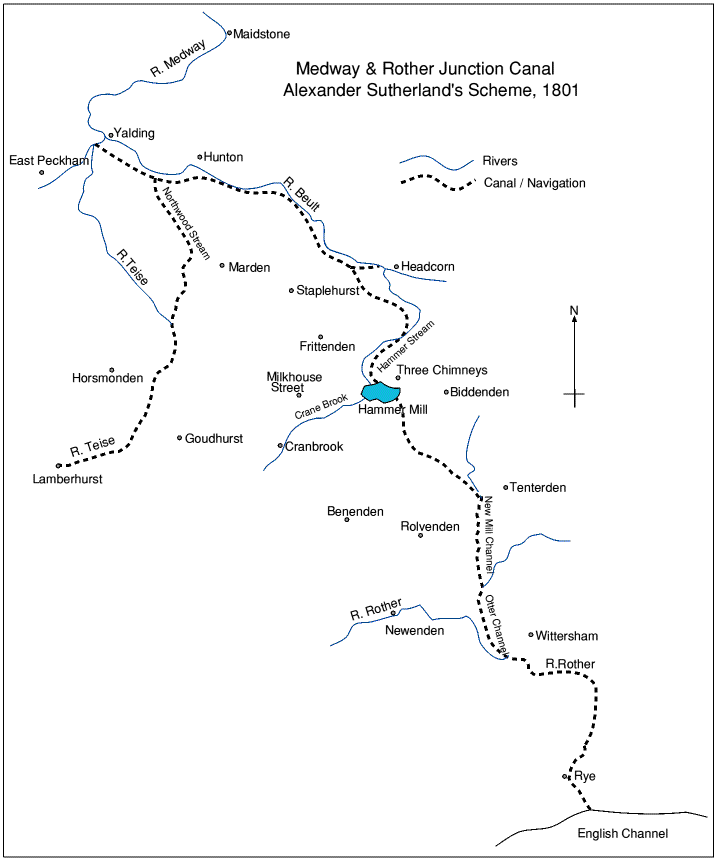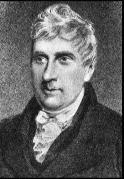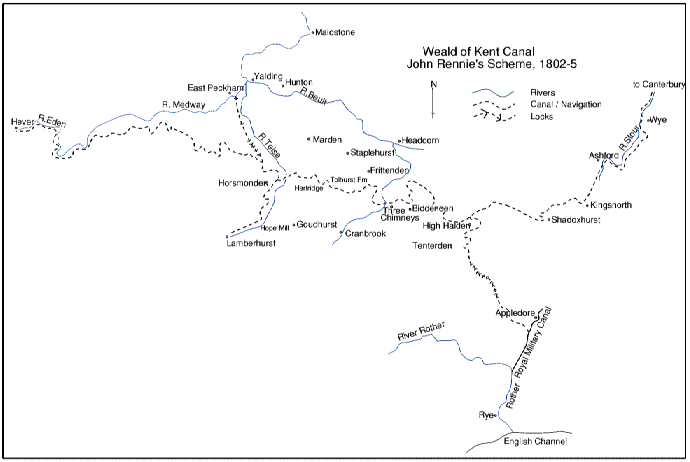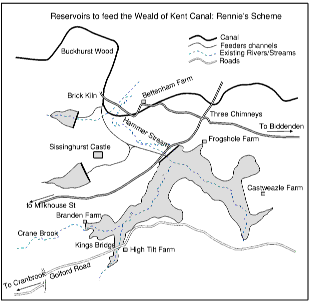|
Kent was comparatively little affected by the canal mania of the late 18th and early 19th centuries. The county's main canal was, of course, the Royal Military Canal, extending into Sussex, though its construction was for defence purposes, rather than the normal commercial ones. Kent's only other canal was a mere nine miles in length, connecting Gravesend and Strood. But during the Napoleonic period there might well have been a third, enabling north-south barge transit through the county by linking the Medway and the Rother - with possible branches to Lamberhurst, Headcorn, and Cranbrook.
The Cranbrook architect, Thomas Dearn, was keenly interested in the project, and his account of the various stages survives (1). It appears that the initial impetus owed much to William Ward, steward of both the Hemsted and the Hole Park estates - both thought likely to benefit (2). A working committee was established in 1800, with Charles Willis, the well known Cranbrook lawyer, as its clerk. Most subsequent meetings were at Cranbrook's George Inn.
The committee's first important move was the appointment of Alexander Sutherland as 'engineer' to survey and propose a suitable line for the canal, or the 'navigation', as it was termed. Sutherland's qualification was his experience in reconstructing Rye's harbour, although Dearn was subsequently to refer to his "imbecility" - which, in all probability, amounted to a lack of experience regarding canal construction. Within a year, Sutherland had completed ambitious plans for the Medway-Rother link and additional elements which caused the renaming of the original 'Medway and Rother Junction Canal' to the 'Medway and Sussex Junction Navigations'.
The main canal, some 28 miles in length, was to start just south of Yalding at the Medway's junction with the Beult. It would run along the south side of the Beult valley past Hawkenbury bridge, but then turn south, passing Frittenden to its west, until at Hammer Mill (on the Cranbrook-Biddenden border) it linked to a new embanked reservoir of some 40
acres. This would be located more or less where the Bakers of Sissinghurst had created a similar pond to power their forge and furnace for iron working over two centuries earlier. To the east of Hammer Mill is the watershed between the tributaries of the Medway, flowing north, and the Rother, flowing south and east. Sutherland planned to build a tunnel, over 400 yards long, to cut through this highest point in the Kentish Weald, south of Fosten Green. The canal would then run east, crossing the Rolvenden to Tenterden road at Ashbourne Mill, where it would join a tributary of the Rother which was to be "widen'd and deepen'd" so that barges could reach the already navigable Otter channel which passes Smallhythe and Reading before flowing into the Rother south of Wittersham.
A second major 'navigation` was to begin not far from the starting point of the main canal near Yalding, and to run for eleven miles along the Teise, which would be widened and straightened in some places, to a quay at Lamberhurst Mill, in the centre of the village. Finally, two extra short branches of the main canal might be constructed, to link it to Headcorn and to Cranbrook. The Cranbrook branch, nearly four miles long, would run from the new Hammer Mill reservoir to a wharf near St David's Bridge; Sutherland warned that its eleven locks and much "cutting" would be costly, and suggested an "iron railway" (which at that date would have been horse-drawn) as a possible alternative.

The canal was to be navigable for barges of up to 40 tons, and was to measure 28 feet wide at the surface, 12 feet wide at the bottom, and only 4 feet deep. Projected total costs were over £103,000 if no Cranbrook branch were built, and over £118,000 if the branch were added. These figures included £31,488 for land purchase and towpath creation, and £24,400 for tunnelling. Projected income was put at £3,350 per year, which, less than convincingly, was predicted to secure investors an 8% annual return 'with every likelihood of more as population and trade increased over the years' (3).
The estimates of income were based on goods normally brought into or taken out of the Weald by land carriage "at an enormous expence". The principal goods envisaged were, in order of value: manure (eg lime, chalk, coal ashes and marl), stone and gravel for roads, oak timber and planks, lesser timber such as deals, bark, cordwood, faggots, hop-poles, building materials (eg bricks and tiles), iron and ironmongery, coal and coke, hides, tallow, hemp, tar, flax, seeds, corn, hops, wool, flour, ale, beer, porter and general groceries from London and Maidstone. All these goods would normally travel by road using carriers' wagons, or by coaster from London to Rye. Wagons carrying freight between Rye and London were currently charging almost three times the 8d per mile which the canal would charge, while the sea journey of 120 miles included serious hazards, particularly when navigating past the Nore, the Goodwin Sands and Dungeness.
These projections, it was hoped, would attract investors, including gentry, businessmen and farmers from the Kentish Weald. Sutherland's survey drew attention to benefits for the locality: easier transportation of agricultural and industrial products; better drainage from the higher lands; better flow of the Teise and Beult into the Medway; less damage to the roads; even, he suggested, stimulus to a revived cloth industry.
Of the 119 subscribers who financed Sutherland's survey, local notables included Earl Camden, Earl Romney and the future Kent MP, Sir William Geary, as well as Cranbrook's Sir Thomas Roberts and Thomas Adams. A separate list of subscribers favouring the branch to Cranbrook included the landlords of the George and the Bull inns as well as leading town tradesmen such as clockmaker, Thomas Ollive, and corn factor, William Buss. By no means all the leading local figures were involved however, one important non-subscriber being Horatio Mann, Lord Cornwallis, owner of extensive estates throughout Cranbrook, Frittenden, and Biddenden, where his tenant farmers might be expected to benefit from the canal.
 John Rennie, 1761 - 1821
John Rennie, 1761 - 1821
In April 1802, evidently at Sutherland's own suggestion, it was decided that he should give way to an engineer who was subsequently to become one of the most eminent public works designers of the first half of the 19th century. This was the Scot, John Rennie, designer of major bridges, canals and docks, still in early middle age in 1802. Sutherland himself died suddenly in the same month of April, and by September Rennie had produced a new survey. He proposed radical amendments to Sutherland's route, using the Teise valley rather than the Beult as the route into the Weald and adding a branch from Hothfield, near Ashford, primarily in order to transport lime from the Chart Hills into the Weald. This branch would meet the main canal at the Hammer Mill reservoir and then run west to Lamberhurst and the Teise (4).

Click to enlarge in new window
By this date the Committee was chaired by William Geary. It included another future Kent MP, the young Thomas Law Hodges, but only one Cranbrook man, Thomas Adams. After more detailed surveying, Rennie was in 1803 suggesting further extensions both eastwards and westwards linking the canal to other proposed schemes, but perhaps on account of the many proposed changes and the extra surveying expenses now incurred, enthusiasm for the project had diminished. Nothing further was heard until August 1807, when a Maidstone Journal notice, referring to a further subscription, made it clear that Rennie and his colleague had not been fully paid for their earlier survey. However, Sir William Geary, now clearly the main champion of the project, gave financial help which met the arrears and financed yet another survey and report by Rennie (5).
Published in August 1809, Rennie's new proposals would have extended the canal still further east, as far as the Stour at Canterbury, and west, to Hever Castle, as part of an extraordinarily ambitious design linking Portsmouth to the Kent dockyards. It seems that the Committee were wary of anything quite so ambitious, but a well attended meeting in Maidstone on April 9, 1810 agreed to open a subscription, with individual shares at £100 each, for up to £360,000, of which total there would be £105,000 reserved, at least for three months, for Kent inhabitants (6). This condition was due to the fact that Rennie's new plan had already attracted £255,000 from outside the county, though only £24,300 from Kent. Kent applicants in fact took up the available £105,000 worth of shares before the end of April.
 Reservoirs planned by Rennie
Reservoirs planned by Rennie
The Committee was expanded so as to comprise eighteen 'Noblemen and Gentlemen', and work began at last towards drafting a private bill, since the project would need Parliament's assent, just as new turnpike proposals did. A setback then occurred, in the form of opposition to a branch of the canal now proposed from High Halden to Chart Hills, from a number of notables in the Ashford area, who were able to organize opposition within Parliament. This, together with yet another proposed alteration, now extending the canal to a link with the Royal Military Canal at Appledore, caused deferral of the bill until April 22, 1811. It then passed its second reading, yet, undoubtedly to the disquiet of the investors, the bill was then withdrawn, apparently because of unsolved problems regarding the link to the Military Canal.
Before resubmission of the bill, a decision which must have disappointed Cranbrook backers was made that the Cranbrook branch should be omitted, partly on the grounds that the amended route crossed the road to Frittenden just north of the Cranbrook parish boundary. Costed now at £32,000, the branch would no longer have run to St David's Bridge, but only to Moat Farm, with a railroad to the town centre.(6)
Further afield, opposition to a new bill was fast strengthening, even to the extent that the Maidstone Journal on January 21, 1812 reported a rebel meeting which passed a resolution to abandon the scheme. Those present, including the chairman, William Rayley, were now not the Kent notables, but apparently City businessmen, major investors who had become disenchanted with the project. Their meeting went so far as to demand the funds to be made over to them within a fortnight. The resubmitted bill's first reading was in fact to take place on February 3, just before the fortnight expired.
The opposition now won over at least two of the Kent gentry, Mr Hatton of Eastwell Park and Mr Austen of Godmersham Park, by persuading them, erroneously, that their interests would be injured by the bill, as the canal would run close, not to their estates, but to the estates of other landowners including MPs in support of the bill. In the face of much lobbying and rumour mongering, the bill's second reading was passed on February 18 by a majority of only ten votes (7).
Within three weeks, its London opponents sought to undermine public confidence by publishing a statement claiming that almost £200,000 of the funds had now been withdrawn from the scheme. The promoters correctly countered that no money had yet been spent on land or construction work, but clearly the capital was by then insufficient. Nevertheless the bill went ahead, and the Act received the royal assent on May 5, 1812.
The first meeting of the new 'Company of Proprietors of the Weald of Kent Canal' took place at the Bell Inn, Maidstone on May 25. A Management Committee of fifteen, including Lord Camden, Lord Romney and Sir William Geary, was formed, with Cranbrook's Charles Willis as one of the two clerks and solicitors (8); no minutes of the meeting survive. It is clear, however, that the new company faced what turned out to be the insoluble problem of raising sufficient capital, now that many investors had withdrawn and confidence in the project had diminished. A condition of the Act gave the Committee three years in which to raise £305,000 before purchasing any property or commencing any work. Maidstone Journal notices of June 1813 and June 1814 make it clear that the necessary funds were not forthcoming, and the deadline was passed in May 1815. It was reported that application would be made to Parliament to extend the deadline but the last newspaper mention of the scheme was in July 1816, when subscribers were asked to pay £2 10s per share to pay off a few outstanding debts.
National canal mania was not over and a good number of schemes came to fruition before the coming of the railways. Rennie continued to work on great civil engineering projects including canals until his death in 1821, when he was buried with great funeral honours in St Paul's Cathedral, near Wren's tomb. But the Weald of Kent Canal investors had received no returns and the Committee's time and resources had been expended to no avail.
References: (CKS = Centre for Kentish Studies)
1) Thomas Dearn, The Weald of Kent, 1813
2) C F Hardy, Benenden Letters, 1901 (Letter no. 157)
3) Survey in Cranbrook Museum
4) CKS U481 P4 and plans kindly lent by Paul Donovan
5) Maidstone Journal (MJ) 28.7.1807 and Rennie Reports, vol 2, p394 (Inst. Civil Engineers)
6) Reference book in CKS Q/RUm31
7) MJ parliamentary report 20.2.1812
8) MJ 26.5.1812
Previously published by Tony Singleton in The Cranbrook Journal No.15, 2004
|